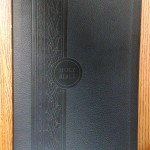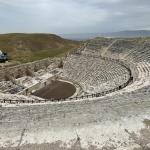I wrote a post about the ESV a few weeks ag0 (which you can find here), and this seems to have sparked a number of debates surrounding the Ecclesiastical Text and the modern Critical Text. James White responded to my post on the Dividing Line, and quite honestly, I had no desire to get into an extensive debate over the issue. However, since White’s program aired, discussion seems to be constant surrounding some of these issues. This is my attempt to give an explanation of my perspective on these issues.
First, let me just explain exactly where the Ecclesiastical Text position comes from. The late Theodore Letis, a Lutheran theologian, argued in his book The Ecclesiastical Text, that there was a fundamental shift in Protestant theology with B.B. Warfield. Traditionally, in both Lutheran and Reformed scholasticism, authority was to be found in the preserved apographa rather than the original autographa. After the rise of textual criticism in the nineteenth century, Protestant theologians began arguing that Biblical inerrancy is to be found solely in the original autographs. Thus, the critical methods of Wescott, Hort, and many others were adopted by the church. Essentially, in this view, the textual criticism of Scripture should not differ from criticism of any other text. Letis argues that, for Protestants, the canon should be identified with the Textus Receptus, which was the Bible used by both the Reformed and Lutheran churches during and after the Reformation.
There are several advocates of a type of “King James Only” position who have utilized similar arguments. Two prominent examples are Edward F. Hills and Thomas Holland. These two writers are the most scholarly of KJVO advocates, and present some convincing arguments for certain TR readings in opposition to the Critical Text. They argue that God especially preserved his word at the time of the Reformation, and thus the texts used in that time period should remain standard for the church.
My personal view is something of a moderated Ecclesiastical Text position. Letis is absolutely correct in his historical overview of the shift from the Reformation to B.B. Warfield. Unfortunately, since the time of Westcott and Hort, Protestants have examined the New Testament manuscripts in the way that they do any other piece of literature. It’s my contention that our view of the canonical text should be guided, in part, by our theology of preservation. We should trust that God provided the necessary text for the church’s theology and life, and consequently that he preserved that text throughout the centuries of the church’s existence.
For these reasons, I prefer the Majority Text over the Critical Text. It’s my contention that we should privilege readings which appear in the majority of New Testament manuscripts over those that don’t. God has promised that he would preserve his Word, and we should trust that he has. This then leads to the question of the TR. Most proponents of the Ecclesiastical Text view tend to privilege the TR over both the Critical Text, and the Majority Text. I prefer the TR for English translations for the simple reason that no modern translation uses the MT. There are, however, some real inconsistencies with the TR for those holding to the Ecclesiastical Text position. The most obvious is 1 John 5:7, which has almost no basis in the entire manuscript tradition. Erasmus didn’t even want to include that text in the first place. If the argument is from preservation, why privilege this one particular text which actually doesn’t seem to have been preserved for the majority of church history? I see no reason from the theology of preservation to somehow assume that the half dozen manuscripts utilized by Erasmus in the compilation that is the TR were providentially used more than any other NT text in church history. The argument of people like Edward Hills that even the latin renderings of the TR are somehow better than the preserved Greek text, is more than a little absurd.
Let me just give one example as to how my perspective on this issue works. The long ending of Mark has been quite a debated issue for some time. There are several early manuscripts which do not contain the long ending, which are in the Alexandrian family. However, the long ending of Mark has clear attestation as early as Irenaeus and Justin Martyr. The Critical Text proponents tend to reject the long ending of Mark, arguing that 1. It was lost, or 2. It never had an ending. From a theological perspective, the problems with option one are obvious. If we do believe in preservation, then we necessarily have to reject the idea that God inspired an ending to one of the canonical books only to have it lost almost immediately. The only two options then are: 1. the long ending is inspired, or 2. Mark just ends abruptly. Because the long ending was accepted so unanimously in church history, even though it’s missing in some early manuscripts, it should be accepted as canonical. This same logic, however, negates the canonicity of 1 John 5:7 and some other TR readings.
I hope this clarifies my position, because I know that my ESV post was used by some to promote a TR only position. While I like the TR, I prefer the Pierpont/Robinson NT Majority Text.















